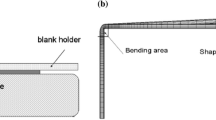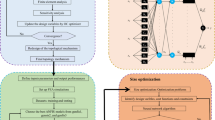Abstract
To overcome the limited stroke of existing micropositioning stages in precision engineering systems, this article proposes an optimal design of a new micropositioner based on the cricket-mimicked bistable mechanism. The suggested micropositioner is potential for polishing application. The proposed bistable mechanism is combined with a positive-stiffness mechanism to achieve a large stroke with centimeter range. The design targets of micropositioner are to deliver a large stroke, a high frequency, and a small parasitic motion but also ensure working safety. To solve three objective functions with four constraints, a hybrid optimization approach is proposed, namely fuzzy logic, teaching learning-based optimization (TLBO), and artificial neural network (ANN). The fuzzy logic is proposed to combine three objective functions into a single objective function, so-called output fuzzy. In the modeling, the TLBO is employed to determine the optimum ANN structure. Then, the multi-objective optimization problem of the micropositioner is converted into the single optimization task through the TLBO. Besides, the influences of the geometrical parameters on the performance qualities of the micropositioner are investigated. The results showed the performance indexes of TLBO-assisted ANN are reasonable and reliable. The optimum design parameters are found at l1 = 60.93 mm, l2 = 10.42 mm, t1 = 2.77 mm, t2 = 1.37 mm, and t3 = 9.28 mm. A prototype of ABS micropositioner is manufactured by fused deposition modeling 3D printer. The displacement and the parasitic motion were experimentally measured about 14.9513 mm and 0.0061 mm, respectively. The frequency and the stress were simulated in ANSYS software about 617.9227 Hz and 38.7659 MPa, respectively. The output stroke is over 1 cm which is potential for wide applications.























Similar content being viewed by others
Data availability
All data that support the findings of this study are available from the corresponding author upon reasonable request.
Not applicable.
References
Gu Y, Chen X, Lin J, Lu M, Lu F, Zhang Z, Yang H (2018) Vibration-assisted roll-type polishing system based on compliant micro-motion stage. Micromachines 9(10):499. https://doi.org/10.3390/mi9100499
Wang J, Du H, Gao S et al (2019) An ultrafast 2-D non-resonant cutting tool for texturing micro-structured surfaces. J Manuf Process 48:86–97. https://doi.org/10.1016/j.jmapro.2019.10.023
Chen W, Zheng L, Xie W et al (2019) Modelling and experimental investigation on textured surface generation in vibration-assisted micro-milling. J Mater Process Technol 266:339–350. https://doi.org/10.1016/j.jmatprotec.2018.11.011
Gu Y, Kang M, Lin J et al (2021) Non-resonant vibration-assisted magnetorheological finishing. Precis Eng 71:263–281. https://doi.org/10.1016/j.precisioneng.2021.03.016
Gong Z, Huo D, Niu Z et al (2022) A novel long-stroke fast tool servo system with counterbalance and its application to the ultra-precision machining of microstructured surfaces. Mech Syst Signal Process 173:109063. https://doi.org/10.1016/j.ymssp.2022.109063
Dinh VB, Le N, Nam C et al (2021) Topology - based geometry optimization for a new compliant mechanism using improved adaptive neuro - fuzzy inference system and neural network algorithm. Eng Comput. https://doi.org/10.1007/s00366-021-01552-y
Ling M, Howell LL, Cao J, Chen G (2020) Kinetostatic and dynamic modeling of flexure-based compliant mechanisms : a survey. 72. https://doi.org/10.1115/1.4045679
Ling M, Zhang X (2021) Coupled dynamic modeling of piezo-actuated compliant mechanisms subjected to external loads. Mech Mach Theory. https://doi.org/10.1016/j.mechmachtheory.2021.104283
Wang Z, Luo X, Liu H et al (2021) A high-frequency non-resonant elliptical vibration-assisted cutting device for diamond turning microstructured surfaces. Int J Adv Manuf Technol 112:3247–3261. https://doi.org/10.1007/s00170-021-06608-3
Huang HB, Sun D, Mills JK, Cheng SH (2009) Robotic cell injection system with position and force control: toward automatic batch biomanipulation. IEEE Trans Robot 25:727–737. https://doi.org/10.1109/TRO.2009.2017109
Hao G, Li H (2015) Conceptual designs of multi-degree of freedom compliant parallel manipulators composed of wire-beam based compliant mechanisms. Proc Inst Mech Eng Part C J Mech Eng Sci 229:538–555. https://doi.org/10.1177/0954406214535925
Fung RF, Hsu YL, Huang MS (2009) System identification of a dual-stage XY precision positioning table. Precis Eng 33:71–80. https://doi.org/10.1016/j.precisioneng.2008.04.002
Chen F, Zhang Q, Gao Y, Dong W (2020) A review on the flexure-based displacement amplification mechanisms. IEEE Access 8:205919–205937. https://doi.org/10.1109/ACCESS.2020.3037827
Wang R, Zhang X (2015) Preload characteristics identification of the piezoelectric-actuated 1-DOF compliant nanopositioning platform. Front Mech Eng 10:20–36. https://doi.org/10.1007/s11465-015-0328-z
Al-Jodah A, Shirinzadeh B, Ghafarian M et al (2020) A fuzzy disturbance observer based control approach for a novel 1-DOF micropositioning mechanism. Mechatronics. https://doi.org/10.1016/j.mechatronics.2019.102317
Dang MP, Le HG, Tran NTD, Chau TN, Chau T-P (2022) Optimal design and analysis for a new 1-DOF compliant stage based on additive manufacturing method for testing medical specimens. Symmetry 14(6):1234. https://doi.org/10.3390/sym14061234
Pinskier J, Shirinzadeh B, Al-Jodah A (2021) Design and evaluation of a dual-stage, compensated stick-slip actuator for long-range, precision compliant mechanisms. Sensors Actuators A Phys 331:113007. https://doi.org/10.1016/j.sna.2021.113007
Xiaochen L, Yanling T (2013) The design and new controller of a 1-DOF precision positioning platform. In: International Conference on Manipulation, Manufacturing and Measurement on the Nanoscale. IEEE, pp 190–194. https://doi.org/10.1109/3M-NANO.2013.6737412
Xu Q (2013) Design, testing and precision control of a novel long-stroke flexure micropositioning system. Mech Mach Theory 70:209–224. https://doi.org/10.1016/j.mechmachtheory.2013.07.016
Science PS, Fusion C, Mohiuddin TMG et al (2021) Ce pte d M us. Mater Des 11:5035–5040
Shang J, Tian Y, Li Z, Wang F, Cai K (2015) A novel voice coil motor-driven compliant micropositioning stage based on flexure mechanism. Rev Sci Instrum 86(9):095001. https://doi.org/10.1063/1.4929867
Wang T, Li Y, Zhang Y et al (2021) Design of a flexure-based parallel XY micropositioning stage with millimeter workspace and high bandwidth. Sensors Actuators, A Phys 331:112899. https://doi.org/10.1016/j.sna.2021.112899
Liao S, Ding B, Li Y, Wang J (2022) Design, assembly, and simulation of flexure-based modular micro-positioning stages. Machines 10(6):421
Ling M, Cao J, Jiang Z et al (2019) Optimal design of a piezo-actuated 2-DOF millimeter-range monolithic flexure mechanism with a pseudo-static model. Mech Syst Signal Process 115:120–131. https://doi.org/10.1016/j.ymssp.2018.05.064
Ding B, Li Y, Xiao X et al (2017) Design and analysis of a 3-DOF planar micromanipulation stage with large rotational displacement for micromanipulation system. Mech Sci. https://doi.org/10.5194/ms-8-117-2017
Pinskier J, Shirinzadeh B, Clark L, Qin Y (2018) Development of a 4-DOF haptic micromanipulator utilizing a hybrid parallel-serial flexure mechanism. Mechatronics. https://doi.org/10.1016/j.mechatronics.2018.01.007
Hao G, Li H (2015) Conceptual designs of multi-degree of freedom compliant parallel manipulators composed of wire-beam based compliant mechanisms. Proc Inst Mech Eng Part C J Mech Eng Sci. https://doi.org/10.1177/0954406214535925
Tsai MJ, Huang JF (2006) Efficient automatic polishing process with a new compliant abrasive tool. Int J Adv Manuf Technol 30:817–827. https://doi.org/10.1007/s00170-005-0126-6
Yu Z, Lin HI (2021) Development of robotic polishing/fettling system on ceramic pots. Int J Adv Robot Syst 18:1–22. https://doi.org/10.1177/17298814211012851
Gu Y, Chen X, Lu F, Lin J, Yi A, Feng J, Sun Y (2019) Development of a novel three degrees-of-freedom rotary vibration-assisted micropolishing system based on piezoelectric actuation. Micromachines 10(8):502. https://doi.org/10.3390/mi10080502
Gu Y, Liu A, Lin J et al (2020) Development of decoupling device for vibration-assisted roller polishing of silicon carbide ceramics. IEEE Access 8:219098–219113. https://doi.org/10.1109/ACCESS.2020.3042996
Venkata Rao R (2016) Review of applications of tlbo algorithm and a tutorial for beginners to solve the unconstrained and constrained optimization problems. Decis Sci Lett 5:1–30. https://doi.org/10.5267/j.dsl.2015.9.003
Işık E, İnallı M, Celik E (2019) ANN and ANFIS approaches to calculate the heating and cooling degree day values: the case of provinces in Turkey. Arab J Sci Eng 44:7581–7597. https://doi.org/10.1007/s13369-019-03852-4
Mariajayaprakash A, Senthilvelan T, Gnanadass R (2015) Optimization of process parameters through fuzzy logic and genetic algorithm - a case study in a process industry. Appl Soft Comput J 30:94–103. https://doi.org/10.1016/j.asoc.2015.01.042
Funding
This research is supported by Industrial University of Ho Chi Minh City (IUH) under grant number 126/HD-DHCN.
Author information
Authors and Affiliations
Contributions
The corresponding author, Thanh-Phong Dao, has been responsible for writing this paper, planning, developing the designs, and analyzing all the obtained data. Ngoc Thoai Tran is responsible for the simulation and modeling. Minh Phung Dang is responsible for determining the suitable parameters and measuring the physical experiment of this paper.
Corresponding author
Ethics declarations
Consent to participate
Not applicable.
Consent for publication
All authors agree to publish.
Competing interests
The authors declare no competing interests.
Additional information
Publisher's note
Springer Nature remains neutral with regard to jurisdictional claims in published maps and institutional affiliations.
Rights and permissions
Springer Nature or its licensor (e.g. a society or other partner) holds exclusive rights to this article under a publishing agreement with the author(s) or other rightsholder(s); author self-archiving of the accepted manuscript version of this article is solely governed by the terms of such publishing agreement and applicable law.
About this article
Cite this article
Tran, N.T., Dang, M.P. & Dao, TP. Design and optimization of a new large stroke micropositioner based on cricket-mimicked bistable mechanism for potential application in polishing. Int J Adv Manuf Technol 127, 123–149 (2023). https://doi.org/10.1007/s00170-023-11489-9
Received:
Accepted:
Published:
Issue Date:
DOI: https://doi.org/10.1007/s00170-023-11489-9




